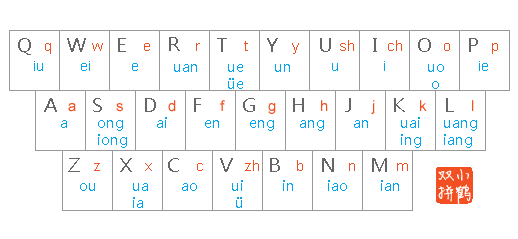Hello everybody, long time no see.
After several months, I finally updated my second article. Now I want to introduce a new input method, different from the usual full spelling, called "Shuangpin". Shuangpin, like full spelling or Wubi, is an input method.
Shuangpin is a method of inputting by using "defined single letters" instead of "longer multi-letter vowels or consonants".
For example, if I want to type the word "programmer" in Pinyin, using the full spelling scheme would require typing "cheng xv yuan", while using the Xiaoxue Shuangpin scheme only requires typing "ig xu yr", which is much more efficient than full spelling.
This article is just an introduction to Shuangpin, and I am only a beginner user. There are many more advanced usage methods that you can learn on your own.
After the article, I will provide several links that are best paired with this article.
In terms of actual usage experience, I can only say that it is faster than full spelling and easier to learn than Wubi.
Concept#
Let's start with a passage from an encyclopedia:
Shuangpin is an input method based on Pinyin input method, which can be regarded as an improvement of full spelling. It maps each multi-letter consonant or vowel in Chinese Pinyin to a specific key, so that each sound can be typed with up to two keystrokes, greatly improving the input speed of Pinyin input method. (This only refers to Pinyin input method...)
I first learned about Shuangpin by reading an article on Shaoshupai A Quick Introduction to Shuangpin Input Method, which recommended using Xiaoxue Shuangpin, and I have been using it ever since (actually, I only learned this one...). Many input methods support Xiaoxue Shuangpin.
Learning Makes Me Happy#
To learn Shuangpin, you need to remember the consonants and vowels corresponding to each key. Here is a table of Xiaoxue Shuangpin, my friend, you must remember it.

At that time, I thought I could practice in my spare time. So I drew a chart like the one above on a piece of paper. It turned out to be very effective. I put it on the table and slowly typed to practice my typing skills. This chart and the mnemonic for Xiaoxue Shuangpin are all you need to learn. At first, I also memorized the mnemonic, but later when I became proficient, I could remember the key positions and forgot the mnemonic...:
[Kuai] [ing] [Liang] [uang] [Ruan] [Cao] [Zou]
快 迎 两 王 软 草 走
[T] [ue] [Qiu] [Yun] [Wei] [Jan] [Mian]
特 约 秋 云 为 见 面
[Xia] [ua] [Song] [iong] [shU] [chI] [zhVi]
夏 娃 怂 恿 书 痴 追
[Geng] [Dai] [Bin] [Niao] [Fen] [Pie] [Hang]
更 待 滨 鸟 分 撇 航
Combine this poem with the keyboard layout above, and you will understand it.
For example, Kuai ing means that when the key K is used as a vowel, it corresponds to two vowels, uai and ing.
Here's an example:
- When I type "快" (kuai), I need to press the keys "kk"
k+uai - When I type "赢" (ying), I need to press the keys "yk"
y+ing
Practice#
Let me introduce an online practice website: Shuangpin Online Practice - typing.sjz.io, please use a desktop browser to access it.
- Practice using the keyboard: http://typing.sjz.io/#/keyboard/
- Practice typing articles: http://typing.sjz.io/#/article/
I recommend starting with ancient poems, as many of them rhyme. It's more enjoyable to type.
Currently, I found that this website doesn't handle the pronunciation of some polyphonic characters well. The markings are not correct, so you need to pay attention to the Pinyin when practicing. Also, if the article is too long, it may lag.
Below, you can download a typing software that allows you to practice typing locally.
Resources#
- Xiaoxue Official Website
- Xiaoxue Shuangpin Baidu Tieba
- Xiaoxue Official Resource Cloud (Typing software is in the Typing Practice folder under the Feiyang Edition directory)
Some Links#
Here are some of the websites I referred to, thank you:
OK, That's all. I hope you will enjoy Shuangpin.